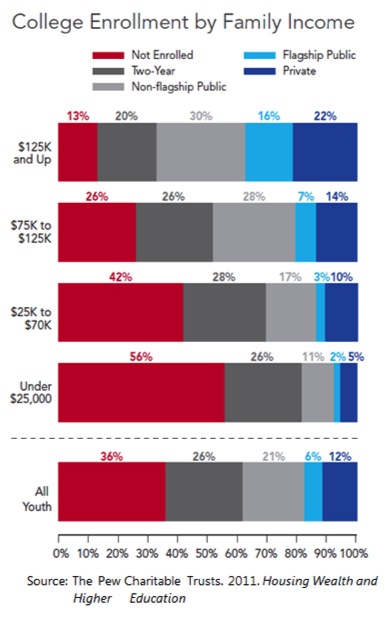Family Income and the Decision to Attend College
May 17th, 2012
Recently, the MEPC blog looked at the gains Mississippi stands to realize from increasing college credential attainment among students. The next few posts investigate which of Mississippi’s students are more likely to pursue higher education and which may need more resources and support as the state seeks to raise educational attainment among its workforce.
Nationally, students from low and moderate-income families are less likely to enroll in post-secondary education and attend top-rated public universities than their higher-income counterparts. The chart shows that 56% of high school graduates from low-income families (income under $25,000) are not enrolled in post-secondary education within 2 years of graduating. In comparison, 26% of students from families with income between $75,000 and $125,000 are not enrolled in higher education.
Students from low-income families are also less likely to attend their state’s flagship university or a private university. For this graphic, flagship universities would include schools like the University of Mississippi, University of Virginia or University of Texas. These campuses often attract a state’s top-tier students and have higher rates of graduation and persistence than other 4-year campuses in the state.
The relationship between income and educational outcomes and post-secondary attendance is well documented. These findings from a report by the Pew Charitable Trusts illustrate how a family’s income is related to a student’s likelihood of attending college, related to the institution they attend, and ultimately can be related to their likelihood of persisting in school.
Understanding these relationships is particularly important in Mississippi where 1 in 3 children grow up in a household with income below the poverty level, and half the state’s African American children live in impoverished households.
Thousands of Mississippi’s high school students and adults need stronger financial aid and resources for support with applying for and enrolling in higher education. These resources are important for ensuring more students receive the post-secondary credentials that are critical to individual economic mobility and the state’s long-term advancement and prosperity.
Part 2. A family’s wealth is measured by the savings and assets they accumulate over time and is distinct from income. A family’s wealth may also affect student decisions related to post-secondary education. MEPC’s next post will explore the relationship between changes in household wealth and college attendance decisions
Author: Sarah Welker, Policy Analyst





